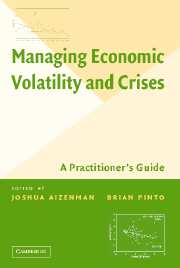Book contents
- Frontmatter
- Contents
- Contributors
- Acknowledgments
- Foreword
- MANAGING ECONOMIC VOLATILITY AND CRISES
- Overview
- PART I WHAT IS VOLATILITY AND WHY DOES IT MATTER?
- 1 Volatility: Definitions and Consequences
- 2 Volatility and Growth
- 3 Volatility, Income Distribution, and Poverty
- PART II COMMODITY PRICES AND VOLATILITY
- PART III FINANCE AND VOLATILITY
- PART IV MANAGING CRISES
- Technical Appendix
- Index
- References
2 - Volatility and Growth
Published online by Cambridge University Press: 25 July 2009
- Frontmatter
- Contents
- Contributors
- Acknowledgments
- Foreword
- MANAGING ECONOMIC VOLATILITY AND CRISES
- Overview
- PART I WHAT IS VOLATILITY AND WHY DOES IT MATTER?
- 1 Volatility: Definitions and Consequences
- 2 Volatility and Growth
- 3 Volatility, Income Distribution, and Poverty
- PART II COMMODITY PRICES AND VOLATILITY
- PART III FINANCE AND VOLATILITY
- PART IV MANAGING CRISES
- Technical Appendix
- Index
- References
Summary
ABSTRACT: This study examines the empirical, cross-country relationship between macroeconomic volatility and long-run economic growth. It addresses four central questions. The first is whether the volatility–growth link depends on country and policy characteristics, such as the level of development or trade openness. The second is whether the link reflects a causal effect from volatility to growth and, if so, whether this effect is statistically and economically significant. The third question concerns the stability of this relationship over time and, in particular, whether the relationship between volatility and growth has become stronger in recent decades. The fourth is whether the volatility–growth connection actually reveals the negative impact of crises, rather than the overall effect of cyclical fluctuations.
The study finds that indeed macroeconomic volatility and long-run economic growth are negatively related. This negative link is exacerbated in countries that are poor, institutionally underdeveloped, undergoing intermediate stages of financial development, or unable to conduct countercyclical fiscal policies. The study finds evidence that this negative relationship actually reflects the harmful effect from volatility to growth. Furthermore, the study finds that the negative effect of volatility on growth has become considerably larger in the last two decades and that it is due mostly to large recessions, rather than to normal cyclical fluctuations.
VOLATILITY AND GROWTH
In the last four decades, the 40 most volatile countries of the 79 sampled in this study have been developing economies (see Tables 2.1 and 2.2).
- Type
- Chapter
- Information
- Managing Economic Volatility and CrisesA Practitioner's Guide, pp. 65 - 100Publisher: Cambridge University PressPrint publication year: 2005
References
- 63
- Cited by



